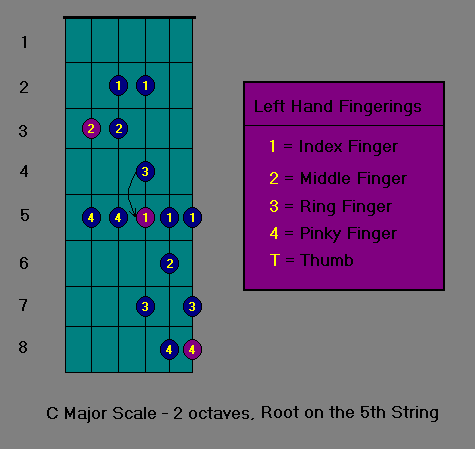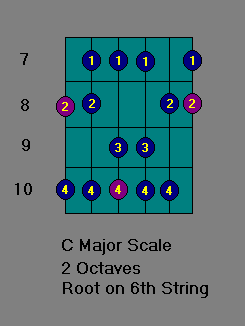Two Patterns for a Major Scale...
This is going to be a short lesson. Here are two very important patterns (fingerings) for a C major scale. These two patterns are essential to your musical vocabulary as they form a foundation for major scale fingerings on the guitar.
The first pattern starts on the 5th string of the guitar and starts in second position. There is a position change midway through the scale which puts you in 5th position. Consult the diagram below. Even though there are 3 root notes in the scale, I want you to use the 5th string as the point of reference to "lock" into this pattern mentally. Think of it as a major scale with the root starting on the 5th string.

The second pattern below is also a two octave C major scale, but this time the root starts on the 6th string of the guitar. There are no position changes in this pattern - it is fixed in 7th position. In this case, I want you to use the low E string as the point of reference to "lock" into this pattern. Think of this pattern as a major scale with the root starting on the 6th string.

Again, these two patterns form the foundation for major scale fingerings for position playing on the guitar. If you only learn two patterns for a major scale these are the ones to learn. If you know the names of the notes on the guitar (covered in the previous lesson) and you know these two patterns, you can play any major scale you want.
For example, if you want to play an A major scale using the second pattern, find the A note on the low E string. (This is the note at the fifth fret.) Place your second finger over this note. You are now "locked into position" and ready to play the A major scale using the second pattern.
If you want to play a D major scale using the first pattern, find the D note on the 5th string. This will put you at the 5th fret as well. Place your second finger over this note. You are now "locked into position" and ready to play the D major scale using the first pattern. And that's all there is to this "method."
In summary:
If you want to play a major scale with the root note starting on the low E string, use the second pattern. If you want to play a major scale with the root note starting on the 5th string, use the first pattern.
It's that easy!
Of course there are other fingerings for a major scale and I will show you these later, but for now I just want to show you the "foundational" patterns. Enjoy!
Proceed to Lesson 5 or go back to the main menu.